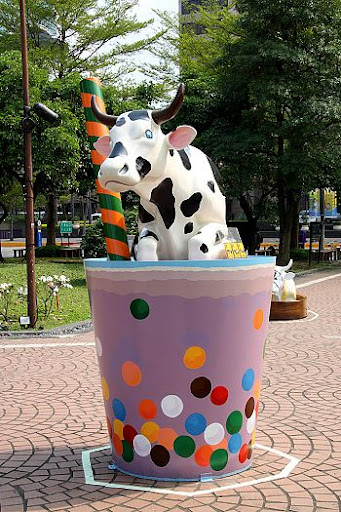
位於台北縣金山鄉的朱銘美術館,原是藝術家朱銘用來放置大型作品的地方,卻因發現放置於戶外與四周環境合而為一的作品,顯得特別的有韻味,而讓朱銘興起了設立美術館與更多人分享的念頭。
Juming Museum is located at Jishan Town, Taipei County. It was originally used to store Juming’s large scale art works. These art works were found to fit into the surrounding environment with a special charm. Juming started the thought to establish an art museum.

於1999年成立的朱銘美術館,佔地約11甲,是台灣最大的戶外美術館。美術館順著地形與地勢規劃出十幾個區域,室內有數個展覽館,室外有藝術表演區、戲水區及數個特色廣場。
The museum was established in 1999 and occupies an area about 11 hectares. It is the largest outdoor art museum in Taiwan. The museum was built along the terrain divided into a dozen regions. There are several indoor exhibition halls, outdoor performing arts area, a water recreation area, and a number of piazzas.

位於太極廣場中的「太極」系列作品,可以說是朱銘最具國際知名度的作品了。朱銘不拘泥於外在形態、不精雕細琢,並以不加修飾的刀法,讓塊面呈現自然斧鑿的紋理,這一個個充滿力度與美感的作品,將太極的精神與內涵完整的呈現出來。這一系列的作品,是我個人最喜歡的系列作品了。
The “Tai Chi” series in the Tai Chi square are the most internationally well-known art works of Juming’s. Juming’s work was to keep the natural texture and look without carving for delicacy. It is fulfilled with strength and beauty of nature and has fully represented the spirit and content of Tai Chi. This is my favorite series.


「人間系列」是朱銘以人為主題,以平實而生活化的題材,描繪出人間百態的系列創作。其中,有不少趣味十足的作品。
“Living World Series” is based on our lifestyles. To describe many different lifestyles with a very simple subject has created several interesting art works.


人間系列中的「三軍」是美術館中數量最為可觀的系列作品,包括陸、海、空三軍及抗戰英雄等,總共有三百多件。這些散落在緩坡綠意間的人形雕塑,是由保麗龍翻鑄成銅的作品,所以近看時,可以發現保麗龍的紋理,也別有一番樸拙感。
The “Armed Forces” of the “Living World Series” has the most displays among all other series in the museum. It includes 300 pieces of art work of “Army”, “Navy”, and “Air Force” heroes including those during the war against the Japanese invasion. These human sculptures are located on the grass area. They are Styrofoam cast bronze work. If you look at them closely, you can find the Styrofoam texture giving a very simple and natural look.

仔細看制服上都有名字,據說這些名字都是贊助作品者的名字呢!如果認養其中一件作品,那麼贊助者的大名就可以出現在人形雕塑上。
There are names on the uniforms. It is said that those are the names of the sponsors. If you adopt one of the works, your name will show up on the human sculpture.

這些人形作品在擺放時,有些會刻意空出位置,如隊伍中空出一個位置,好讓遊客可以化身其中一名士兵拍照留念,我想這是美術館希望人們能與藝術更加親近的作法吧!(看到"長官來了",我們忍不住向他敬禮!)
Among all these human sculptures, a vacant space is deliberately shown among them. For example, the space is for visitors to take a picture with the sculpture. I think this is the way to have visitor interacting with the arts. (Here are the soliders! Let’s salute!)

人間系列「科學家」有中外科學家的雕塑,如蔡崙(造紙)、畢昇(活字印刷)、牛頓、愛因斯坦及居禮夫人等等。這個區域裡有各式各樣的水生植物,還有親子戲水區,很適合小朋友在此遊玩.
“The Scientists” of the “Living World Series” has world famous scientists’ sculptures. There are Cai Lun (paper), Bi Sheng (movable type), Newton, Einstein and Madame Curie.. Etc. This is also a region for children to play and it has a lot of water play areas for chaildren. A variety of aquatic plants can also been seen here.

美術館裡有一區叫做「朱雋館」,是專門陳列朱銘長子也是位知名雕刻家-朱雋的「拉鍊系列」作品。照片裡的作品為拉鍊荷花池。
“Jujun Building” is an area that has Jujun’s “Zipper Series”. He is the eldest son of Juming and is also a well-known sculptor. The photo is showing the “Zipper Lotus Pond”.

照片裡的金字塔形建築為美術館本館,館內除了展示人間系列的彩繪木雕與游泳系列作品外,還有朱銘早期的木雕與燒陶作品,及其恩師李金川與楊英風的作品和史料。
The pyramid-shaped building is the museum. Beside the colored sculptures of the “Living World Series” and the “Swimming Series”, it also has the early time Juming’s wood and pottery work, his teachers Li, Jinchuan, and Yang, YinFong’s work and historical data.

進美術館本館前,還得「排排隊」哦! 據說,下雨時美術館的遊客特少,為了不讓美術館在雨天時太過冷清,朱銘便創作了一些穿雨衣、帶雨具的「遊客」。這樣的話,無論何時本館門前都是「遊客如織」呀!
Don’t forget to get in line to enter the museum! It is said that there are not many visitors in the museum when it rains. In order not to let the museum look too empty, Juming created these “visitors” with rain coats on. In this case, there are always visitors showing up at the entrance door.

人間系列「游泳」,朱銘嘗試以不鏽鋼材質來創作。特別的是,每個女孩千姿百態,有的拉筋暖身、有的坐在池畔戲水,還有躺在躺椅上賣弄風騷,雖然題目為「游泳」,卻見不到任何一件正在游泳的作品,朱銘想表現的其實不是游泳本身,而是那種玩水的歡愉情緻。
The “Swimming Series” is made with stainless steel by Juming. It is very special that each girl sculpture has different style; some are stretching warm-up, some sit in the pool swimming, some are lying on the couch flirting. Although the theme is “Swimming”, I can’t see any works related to ‘Swimming”. I think Juming would like to present the atmosphere of water fun instead of “Swimming” itself.

朱銘美術館腹地廣大,作品也相當多,無法在文章裡一一介紹,想了解更多資訊可至朱銘美術館的官網裡查看哦!
最後,來考考大家!猜猜看,這一排學生裡頭,為何有一件木雕沒有上色?
Juming Museum is very huge with lots of exhibitions. I can’t cover it all. There are more his art works in Juming's official website .
Let’s guess! Why does this sculpture have no color among all others in the above photo?
順遊景點:
The nearby attraction: Jin Shan “Mystery Coast” and Old Street Meal Experience Read More












































